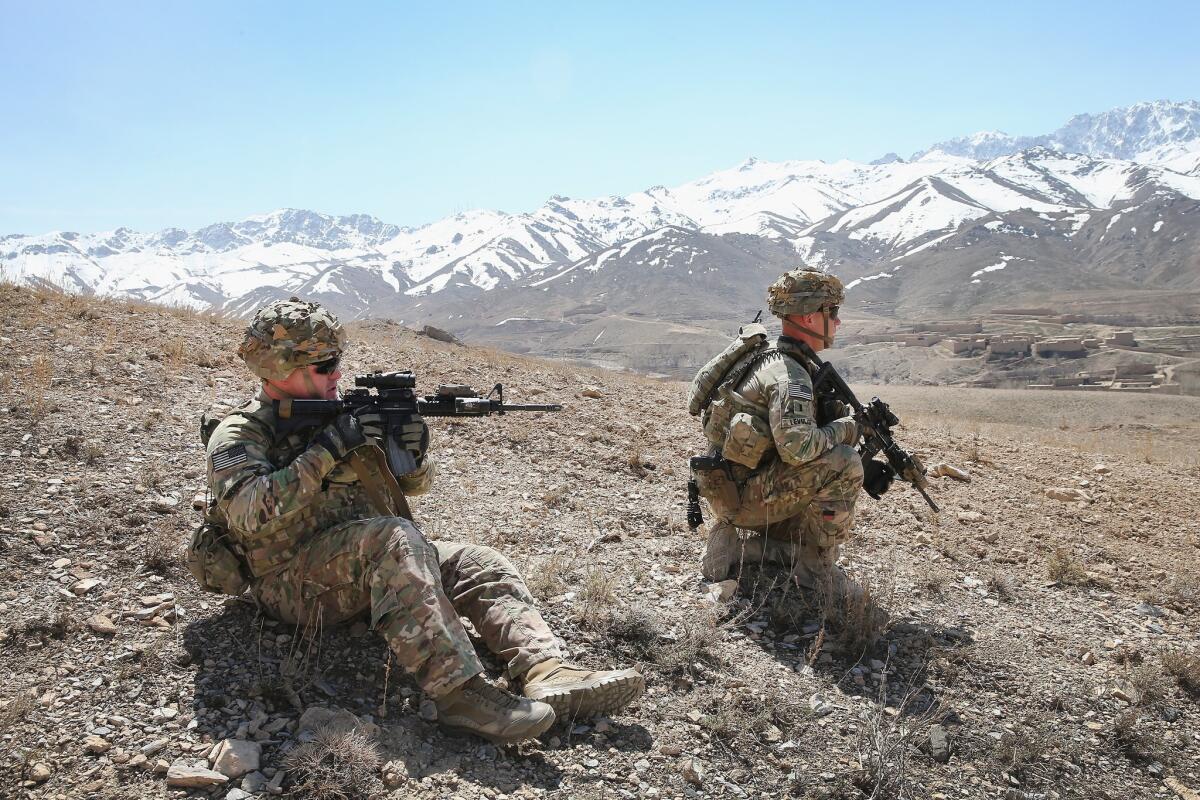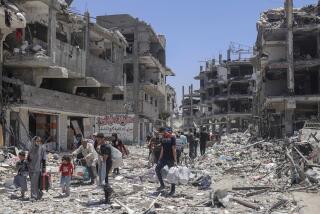CIA’s plan to retrench in Afghanistan worries U.S. military

- Share via
Reporting from Washington — The CIA is planning to close its satellite bases in Afghanistan and pull all its personnel back to Kabul by early summer, an unexpectedly abrupt withdrawal that the U.S. military fears will deprive it of vital intelligence while thousands of American troops remain in the country, U.S. officials said.
CIA Director John Brennan informed U.S. military commanders in March that his agency would shutter operations outside Kabul, removing CIA case officers and analysts as well as National Security Agency specialists responsible for intercepting insurgent phone calls and other communications, a rich source of daily intelligence, the officials said.
Pentagon officials warn that the CIA drawdown after 12 years of war is coming just as insurgent attacks are normally at their peak. As a result, the CIA withdrawal has strained relations between the agency and military commanders in Kabul, the officials said.
“They are beginning their own retrograde and they kind of sprung it on the military, which is raising concern,” a senior military official, using the military term for retreat, said on condition of anonymity because he was not authorized to discuss classified CIA plans.
Intelligence officials confirmed the drawdown, but said the pace is still uncertain. They linked the CIA move to the steady pullout of U.S. military forces who normally provide protection and logistical support for the network of intelligence-gathering outposts, which often are hidden inside U.S. military bases. Hundreds of those forward operating bases have now closed, although dozens are still operating.
“There is no stomach in the building for going out there on our own,” said a former CIA operator who has spoken to current officers about the pullback. “We are not putting our people out there without U.S. forces.”
The CIA also plans this summer to stop paying the salaries of Afghan paramilitary forces that it has armed and trained for more than a decade to help fight the Taliban-led insurgency in eastern Afghanistan, near the Pakistani border. It’s unclear what will happen to the militias.
The Pentagon is seeking to persuade the CIA to slow its withdrawal, arguing that keeping CIA and NSA operators in the field as long as possible will help prevent a surge in insurgent attacks before the end of 2014, when most U.S. troops are due to leave.
Gen. Joseph Dunford, the top commander in Afghanistan, has offered to help the CIA close its intelligence-gathering installations and remove its equipment later this year. By taking on that task, he hopes to persuade the CIA to remain in the field at least until October, one of the officials said.
Pentagon officials are also exploring whether the military can take over paying the salaries of the CIA-backed militias, in order to keep the Afghan fighters from leaving the fight or switching sides, officials said. Some of the front-line units already have been disbanded, according to a report in the Daily Beast.
Brennan told military officials that the CIA would be able to continue gathering intelligence and targeting militants, even after pulling back to Kabul and Bagram and withdrawing many of its personnel, one official said.
The spy service already has sharply cut back the pace of lethal drone strikes in neighboring Pakistan, but one official said the agency was making plans to continue operating the armed drones on a much smaller scale from Bagram.
Al Qaeda commanders, including the terrorist network’s leader, Ayman Zawahiri, are still are believed to be hiding in northwest Pakistan. The tribal belt also serves as a base for fighters from the Haqqani network, which is allied with the Taliban and launched numerous attacks against U.S. and NATO forces in Afghanistan.
Brennan told the military that CIA faced other priorities outside Afghanistan and Pakistan that were compelling it to pull many if its people out, the official said.
The agency is increasingly active in Yemen and parts of Africa, for example, as Al Qaeda has morphed into regional affiliates and wannabe groups.
Inside the CIA, the Sept. 11, 2012, attack on U.S. diplomatic and CIA compounds in Benghazi, Libya, which was considered far less dangerous than the war zone in Afghanistan, highlighted the risk of operating with local security and a light footprint. That attack killed four Americans, including two ex-Navy SEALs working for the CIA.
The agency suffered one of its worst losses ever, however, when a suicide bomber got into a CIA facility inside a U.S. military camp near Khost in eastern Afghanistan on Dec. 30, 2009. The explosion killed seven American CIA officers and contractors, as well as a Jordanian intelligence officer and an Afghan working for the CIA.
Col. Jane Crichton, Dunford’s spokeswoman, declined to comment Thursday.
The dispute has arisen as the Obama administration is nearing a final decision on the size and mission of the force that the U.S. hopes will remain in Afghanistan after this year.
Afghanistan’s outgoing president, Hamid Karzai, a harsh critic of U.S. policy in his country, has refused for months to sign a bilateral security agreement that his government had negotiated with Washington to permit a residual U.S. military force to remain beyond 2014.
U.S. officials hope Karzai’s successor will sign the pact. Elections were held in April, and the two leading contenders, former Foreign Minister Abdullah Abdullah and former World Bank executive Ashraf Ghani, will face a runoff in June.
Some White House officials have renewed a push to keep the mission limited to going after the remnants of Al Qaeda and its supporters. These officials favor abandoning plans to continue training and advising Afghan troops after 2014, arguing that little more will be accomplished by a wider mission, officials said.
The CIA’s abrupt withdrawal plan may be an indication of growing support within Obama’s inner circle for a small U.S. footprint centered on Kabul and at Bagram air base north of the capital, where the CIA would shift its drone operations, one of the officials said.
Dunford is continuing to push for keeping more than 10,000 American troops to continue training and advising Afghan military and police, as well as for counter-terrorism operations, officials said.
Military officials hope to persuade the CIA to keep a presence in Afghanistan’s south and east after this year if the White House approves Dunford’s troop plan. It calls for keeping small numbers of advisors, trainers and special operations troops at a handful of locations outside Kabul.
But some in the White House believe there will be minimal results from continued training, because the mission is only scheduled for a year or two more. For that reason, they are urging Obama to keep any remaining U.S. force focused on going after Al Qaeda remnants, the officials said.
A senior U.S. official said military officials are pressing the White House for a decision soon on post-2014 troop levels, in order to give them time to remove forces and equipment by the year-end deadline or to put in place the force that will stay behind.
“The military is reaching a point where we need a decision, one way or another,” said one of the officials. “We’ve given the White House multiple options.”
Staff writer Ken Dilanian in Washington contributed to this report.
More to Read
Sign up for Essential California
The most important California stories and recommendations in your inbox every morning.
You may occasionally receive promotional content from the Los Angeles Times.














